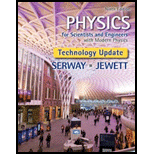
Concept explainers
The circumstances in which a spatially uniform magnetic field cannot exert a magnetic force on a particle.
Answer to Problem 1OQ
Option (c) The particle moves parallel to the magnetic field and option (e) the particle is at rest.
Explanation of Solution
A uniform magnetic field cannot exert a magnetic force only when the particle is not charged and moving at an angle of
Conclusion:
As a spatially uniform magnetic field cannot exert a magnetic force on the particle moving parallel to the magnetic field. Therefore, option (c) is correct.
As a spatially uniform magnetic field cannot exert a magnetic force on the particle which is at rest. Therefore, option (e) is correct.
As a spatially uniform magnetic field can exert a magnetic force on the particle which is charged. Therefore, option (a) is incorrect.
As a spatially uniform magnetic field can exert a magnetic force on the particle which moves perpendicular to the magnetic field. Therefore, option (b) is incorrect.
A spatially uniform magnetic field can exert a magnetic force on the particle when the magnitude of the magnetic field changes. Therefore, option (d) is incorrect.
Want to see more full solutions like this?
Chapter 29 Solutions
Physics for Scientists and Engineers with Modern Physics, Technology Update
- Rank the magnitudes of' the forces exerted on the following particles from largest to smallest. In your ranking, display any cases of equality, (a) an electron moving at 1 Mm/s perpendicular to a 1-mT magnetic field (b) an electron moving at 1 Mm/s parallel to a 1-mT magnetic field (c) an electron moving at 2 Mm/s perpendicular to a 1-mT magnetic field (d) a proton moving at 1 Mm/s perpendicular to a 1-mT magnetic field (e) a proton moving at 1 Mm/s at a 45 angle to a 1-mT magnetic fieldarrow_forwardA proton travels with a speed of 3.00 106 m/s at an angle of 37.0 with the direction of a magnetic field of 0.300 T in the +y direction. What are (a) the magnitude of the magnetic force on the proton and (b) its acceleration?arrow_forwardA proton (charge +e, mass mp), a deuteron (charge +e, mass 2mp), and an alpha particle (charge +2e, mass 4mp) are accelerated from rest through a common potential difference V. Each of the particles enters a uniform magnetic field B, with its velocity in a direction perpendicular to B. The proton moves in a circular path of radius p. In terms of p, determine (a) the radius rd of the circular orbit for the deuteron and (b) the radius r for the alpha particle.arrow_forward
- A charged particle is traveling through a uniform magnetic field. Which of the following statements are true of the magnetic field? There may be more than one correct statement. (a) It exerts a force on the particle parallel to the field. (b) It exerts a force on the particle along the direction of its motion. (c) It increases the kinetic energy of the particle. (d) It exerts a force that is perpendicular to the direction of motion. (e) It does not change the magnitude of the momentum of the particle.arrow_forwardRank the magnitudes of the following magnetic fields from largest to smallest, noting any cases of equality. (a) the field 2 cm away from a long, straight wire carrying a current of 3 A (b) the Held at the center of a flat, compact, circular coil, 2 cm in radius, with 10 turns, carrying a current of 0.3 A (c) the field at the center of a solenoid 2 cm in radius and 200 cm long, with 1 000 turns, carrying a current of 0.3 A (d) the field at the center of a long, straight, metal bar, 2 cm in radius, carrying a current of 300 (e) a field of 1 mTarrow_forwardA proton (charge + e, mass mp), a deuteron (charge + e, mass 2mp), and an alpha particle (charge +2e, mass 4mp) are accelerated from rest through a common potential difference V. Each of the particles enters a uniform magnetic field B, with its velocity in a direction perpendicular to B. The proton moves in a circular path of radius rp. In terms of rp, determine (a) the radius rd of the circular orbit for the deuteron and (b) the radius ra for the alpha particle.arrow_forward
- Calculate the magnitude of the magnetic field at a point 25.0 cm from a long, thin conductor carrying a current of 2.00 A.arrow_forwardA horizontal power line oflength 58.0 in carries a current of 2.20 kA northward as shown in Figure P29.41. The Earths magnetic field at this location has a magnitude of 5.00 10-5 T. The field at this location is directed toward the north at an angle 65.0 below the power line. Find (a) the magnitude and (b) the direction of the magnetic force on the power line.arrow_forward
 Principles of Physics: A Calculus-Based TextPhysicsISBN:9781133104261Author:Raymond A. Serway, John W. JewettPublisher:Cengage Learning
Principles of Physics: A Calculus-Based TextPhysicsISBN:9781133104261Author:Raymond A. Serway, John W. JewettPublisher:Cengage Learning Physics for Scientists and Engineers, Technology ...PhysicsISBN:9781305116399Author:Raymond A. Serway, John W. JewettPublisher:Cengage Learning
Physics for Scientists and Engineers, Technology ...PhysicsISBN:9781305116399Author:Raymond A. Serway, John W. JewettPublisher:Cengage Learning Glencoe Physics: Principles and Problems, Student...PhysicsISBN:9780078807213Author:Paul W. ZitzewitzPublisher:Glencoe/McGraw-Hill
Glencoe Physics: Principles and Problems, Student...PhysicsISBN:9780078807213Author:Paul W. ZitzewitzPublisher:Glencoe/McGraw-Hill College PhysicsPhysicsISBN:9781285737027Author:Raymond A. Serway, Chris VuillePublisher:Cengage Learning
College PhysicsPhysicsISBN:9781285737027Author:Raymond A. Serway, Chris VuillePublisher:Cengage Learning
 Physics for Scientists and Engineers: Foundations...PhysicsISBN:9781133939146Author:Katz, Debora M.Publisher:Cengage Learning
Physics for Scientists and Engineers: Foundations...PhysicsISBN:9781133939146Author:Katz, Debora M.Publisher:Cengage Learning





